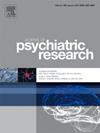Gender differences in the co-occurrence of anxiety and depressive symptoms among early adolescents: A network approach
IF 3.7
2区 医学
Q1 PSYCHIATRY
引用次数: 0
Abstract
Gender differences have been identified in the co-occurrence of anxiety and depressive symptoms. However, the underlying mechanisms that give rise to this gender difference remain unclear, and few studies have examined the issue at the symptom level. The current study employed the 7-item Generalized Anxiety Disorder scale (GAD-7) and the 9-item Patient Health Questionnaire (PHQ-9) to assess anxiety and depressive symptoms in a national sample of early adolescents (N = 15 391). A network approach was applied to investigate the gender differences in symptom interconnectivity. Gender differences were found in the co-occurrence of anxiety and depressive symptoms. The results indicated that girls with higher global strength (p < 0.01) exhibited stronger interconnectivity between symptoms. Central symptom PHQ2 (Sad mood) was significantly stronger in girls (p < 0.01), whereas PHQ6 (Guilt) was stronger in boys (p < 0.05). GAD7 (Feeling afraid) was identified as a prominent bridge symptom in girls, while PHQ6 (Guilt) was observed to play a similar role in boys. The directed acyclic graphs (DAGs) demonstrated that one symptom of anxiety triggered a series of emotional symptoms of anxiety and depression, ultimately resulting in a depressive somatic symptom in girls, whereas leading to both depressive somatic and anxiety symptoms in boys. These findings enhance our understanding and provide insights into potential intervention targets to prevent the co-occurrence of anxiety and depressive symptoms at an early stage.
青少年焦虑和抑郁症状并存的性别差异:网络方法
在焦虑和抑郁症状的共同出现方面,已经发现了性别差异。然而,导致这种性别差异的内在机制仍不清楚,也很少有研究从症状层面来研究这一问题。本研究采用了 7 项广泛性焦虑症量表(GAD-7)和 9 项患者健康问卷(PHQ-9)来评估全国早期青少年样本(N = 15 391)中的焦虑和抑郁症状。研究采用了网络方法来调查症状相互关联性的性别差异。在焦虑和抑郁症状的共同出现方面发现了性别差异。结果表明,总体强度(p < 0.01)较高的女孩表现出症状之间更强的相互关联性。女孩的中心症状 PHQ2(悲伤情绪)明显更强(p < 0.01),而男孩的 PHQ6(内疚感)更强(p < 0.05)。女孩的 GAD7(恐惧感)被认为是一个突出的桥梁症状,而男孩的 PHQ6(内疚感)也起着类似的作用。有向无环图(DAG)表明,一种焦虑症状会引发一系列焦虑和抑郁的情绪症状,最终导致女孩出现抑郁性躯体症状,而导致男孩同时出现抑郁性躯体症状和焦虑症状。这些发现加深了我们的理解,并为潜在的干预目标提供了启示,以在早期预防焦虑和抑郁症状的同时出现。
本文章由计算机程序翻译,如有差异,请以英文原文为准。
求助全文
约1分钟内获得全文
求助全文
来源期刊

Journal of psychiatric research
医学-精神病学
CiteScore
7.30
自引率
2.10%
发文量
622
审稿时长
130 days
期刊介绍:
Founded in 1961 to report on the latest work in psychiatry and cognate disciplines, the Journal of Psychiatric Research is dedicated to innovative and timely studies of four important areas of research:
(1) clinical studies of all disciplines relating to psychiatric illness, as well as normal human behaviour, including biochemical, physiological, genetic, environmental, social, psychological and epidemiological factors;
(2) basic studies pertaining to psychiatry in such fields as neuropsychopharmacology, neuroendocrinology, electrophysiology, genetics, experimental psychology and epidemiology;
(3) the growing application of clinical laboratory techniques in psychiatry, including imagery and spectroscopy of the brain, molecular biology and computer sciences;
 求助内容:
求助内容: 应助结果提醒方式:
应助结果提醒方式:


